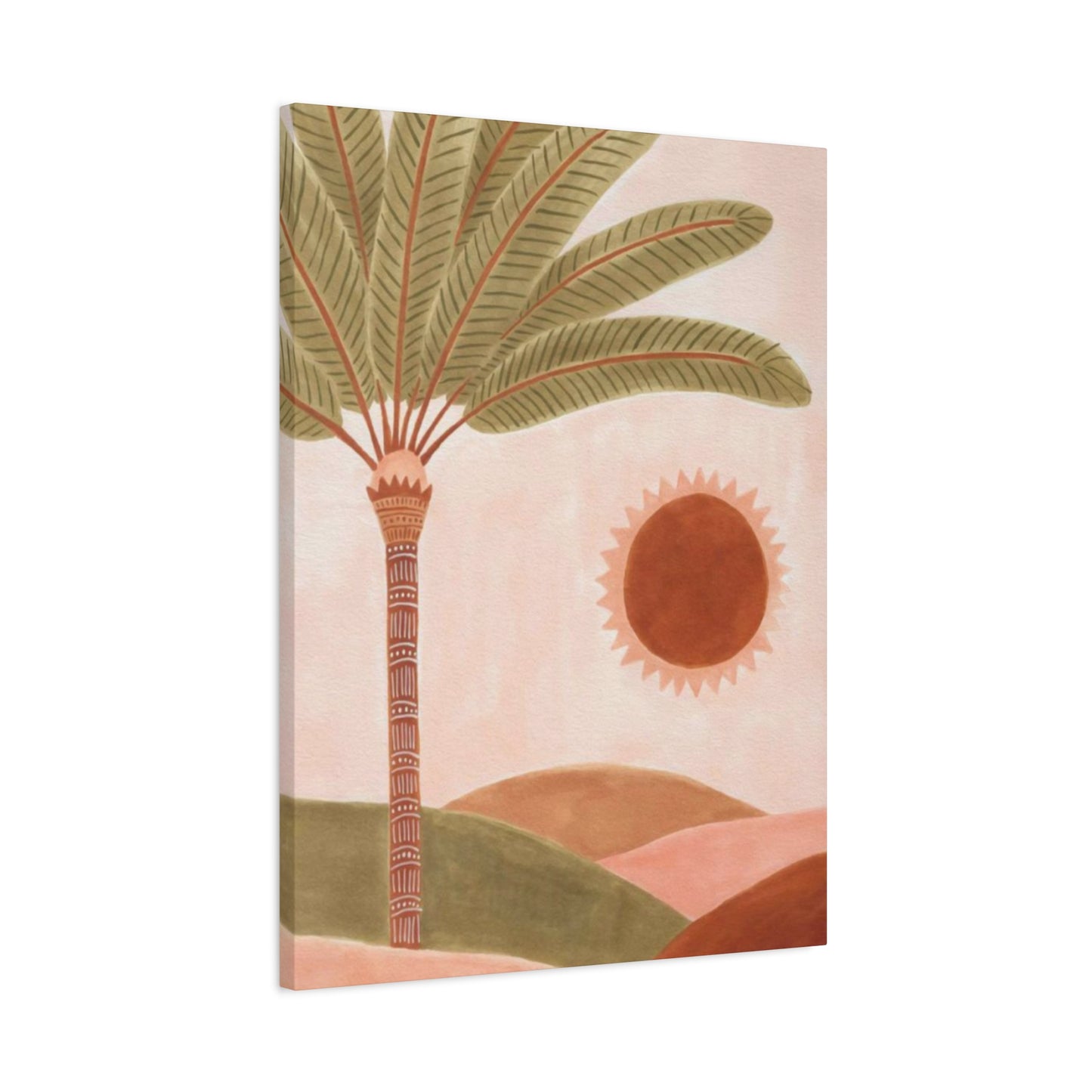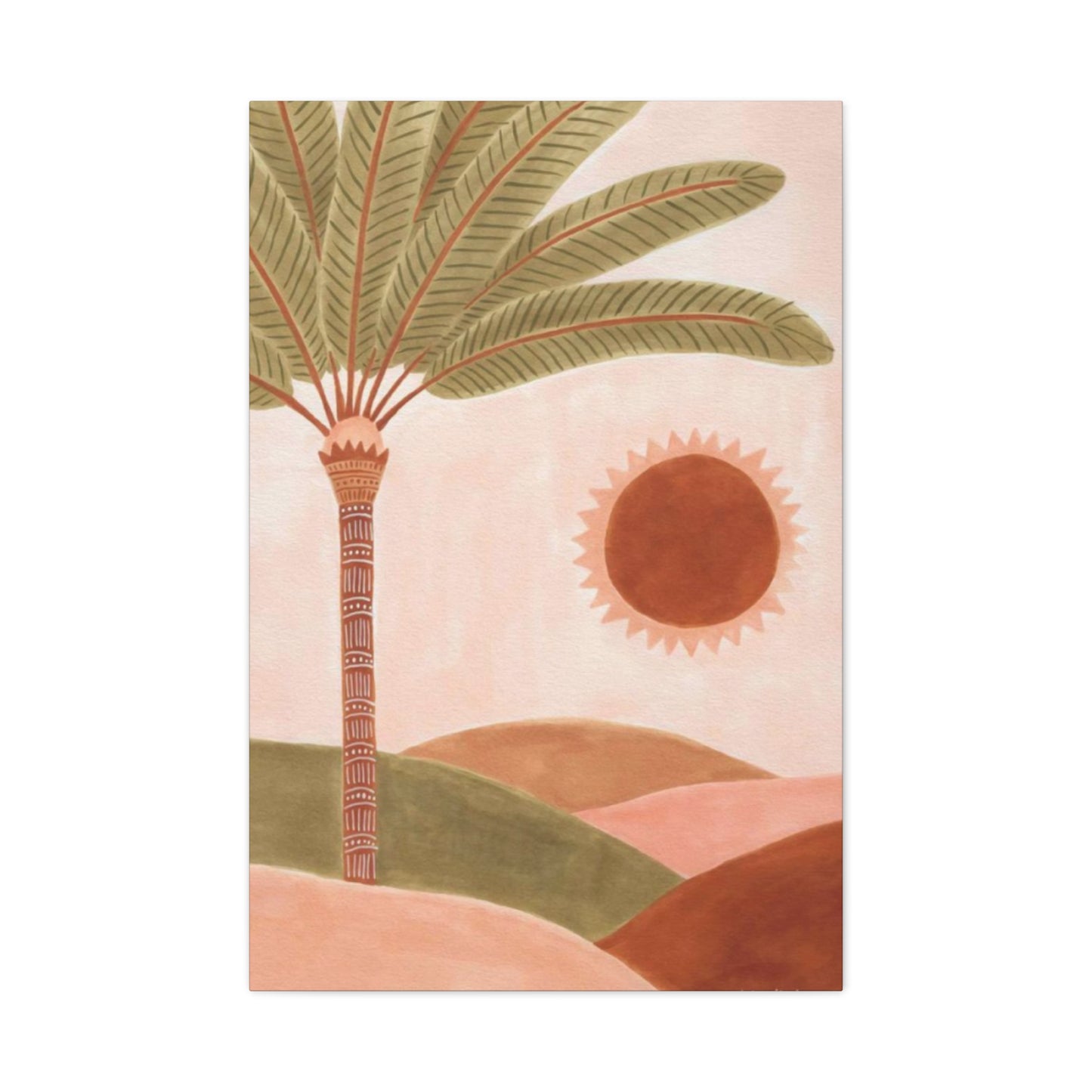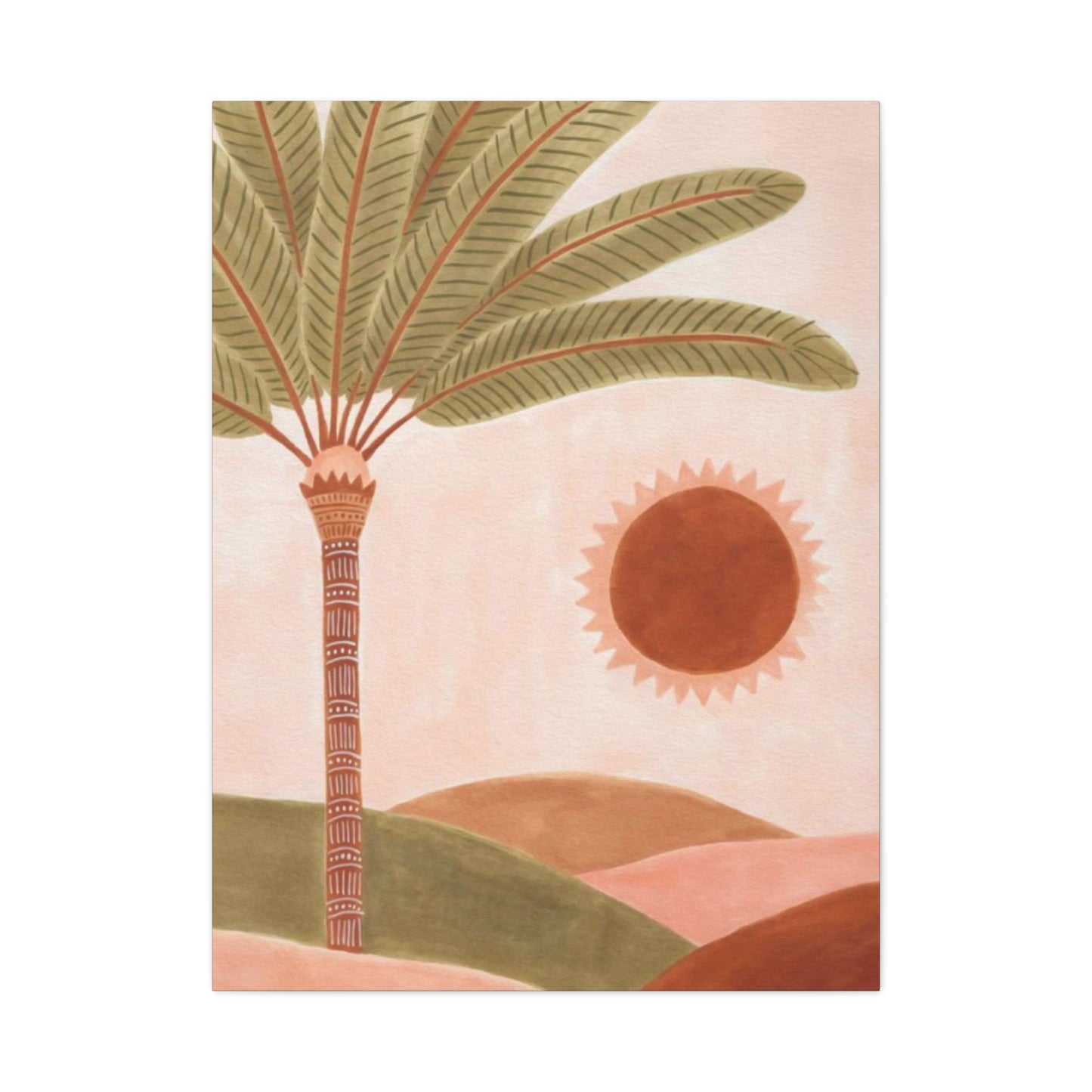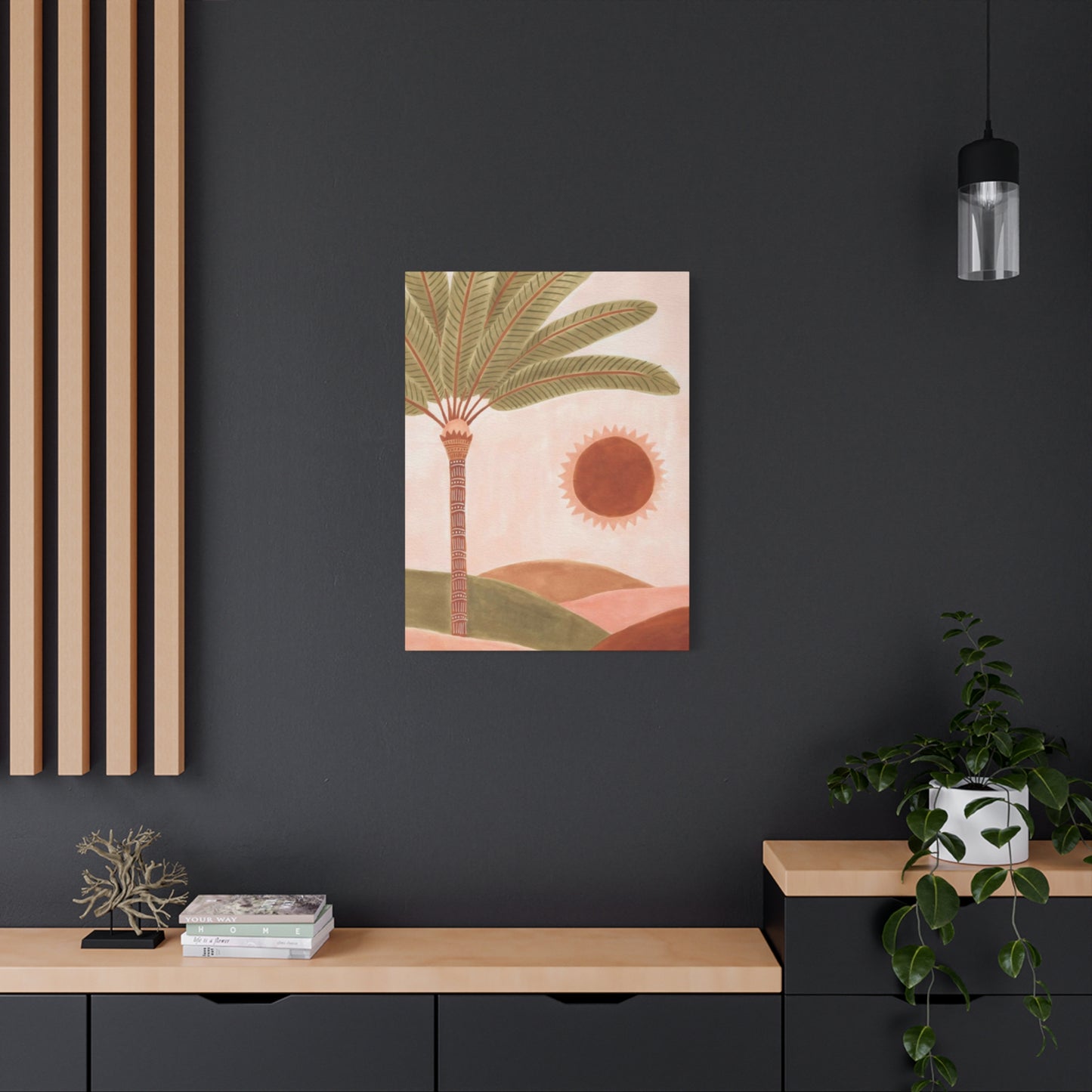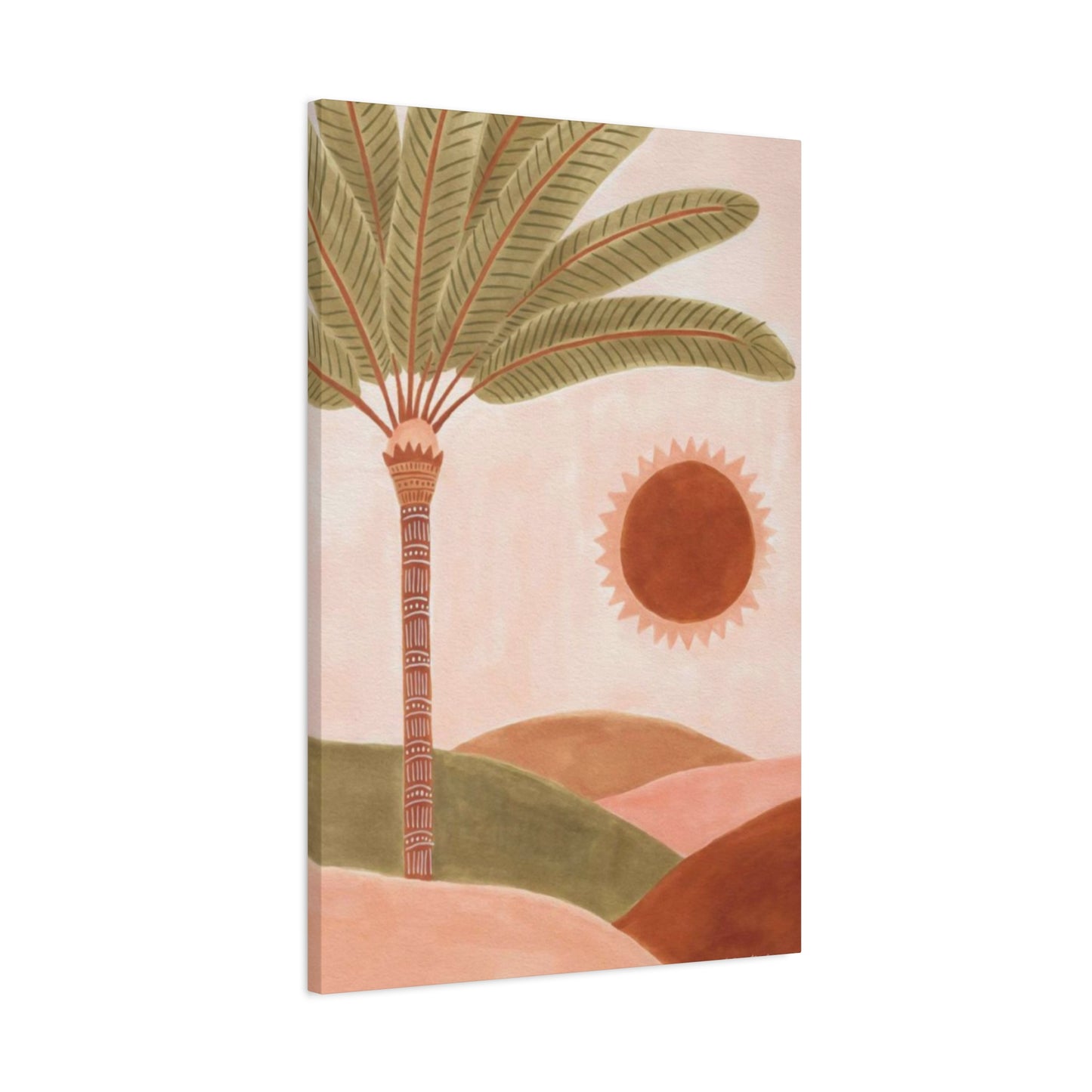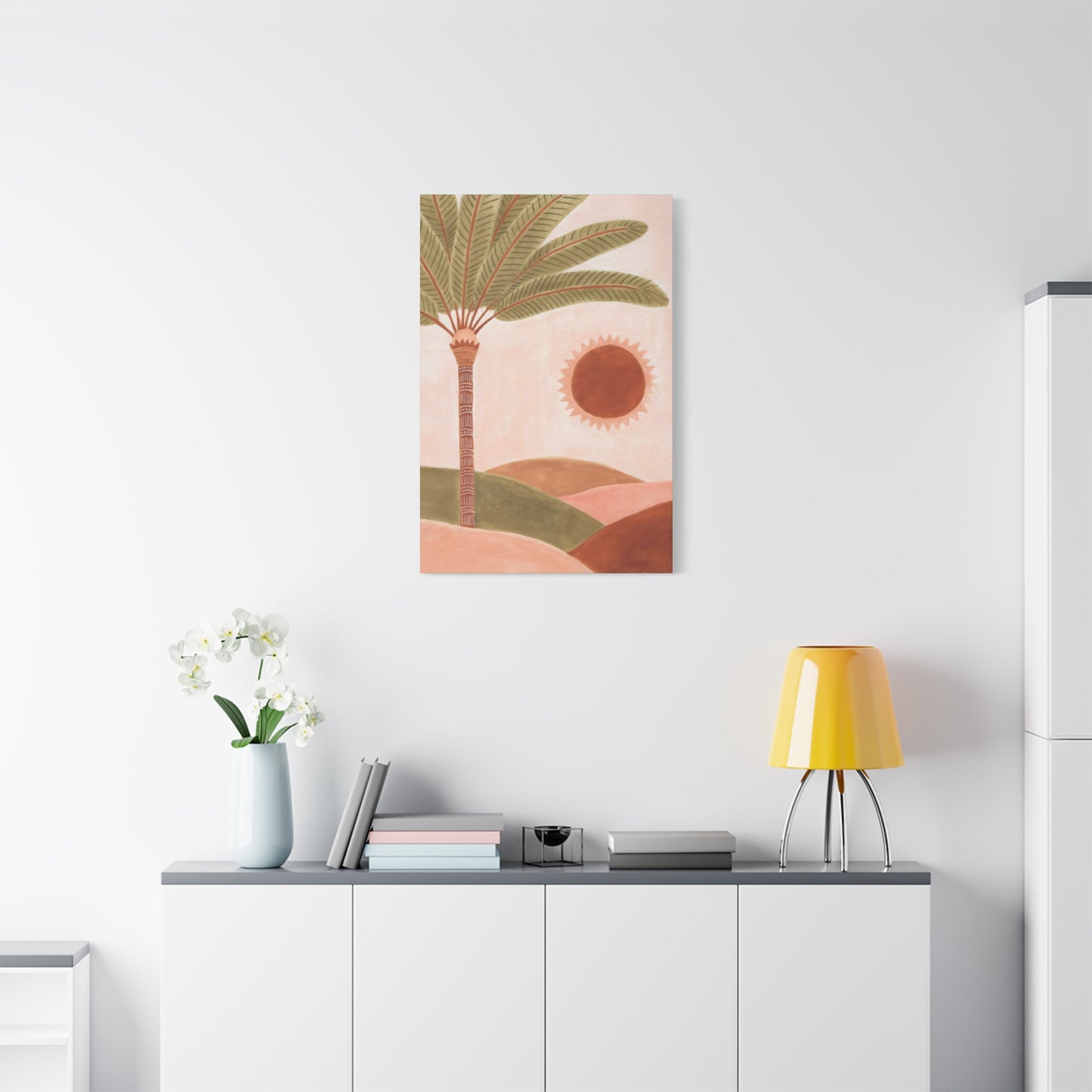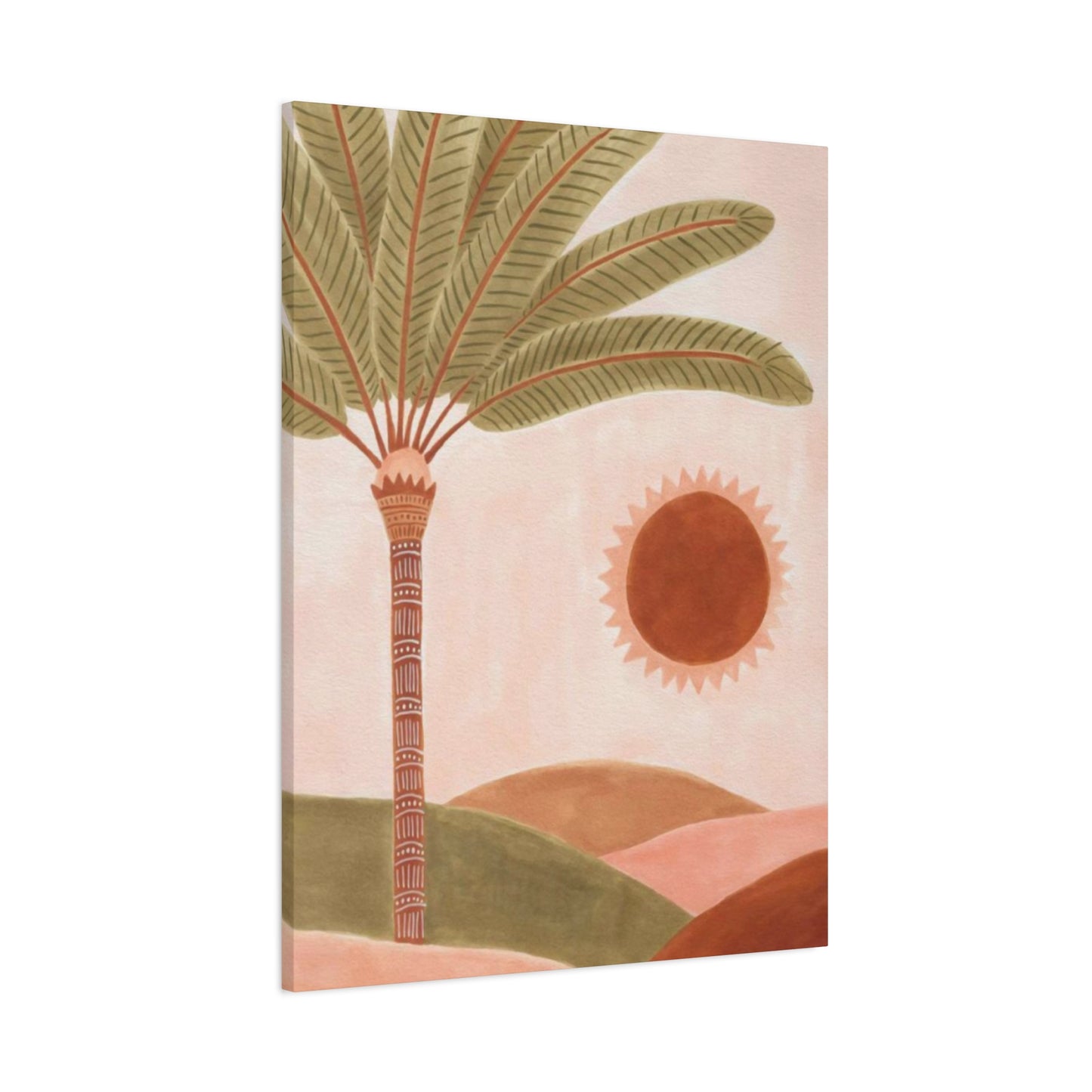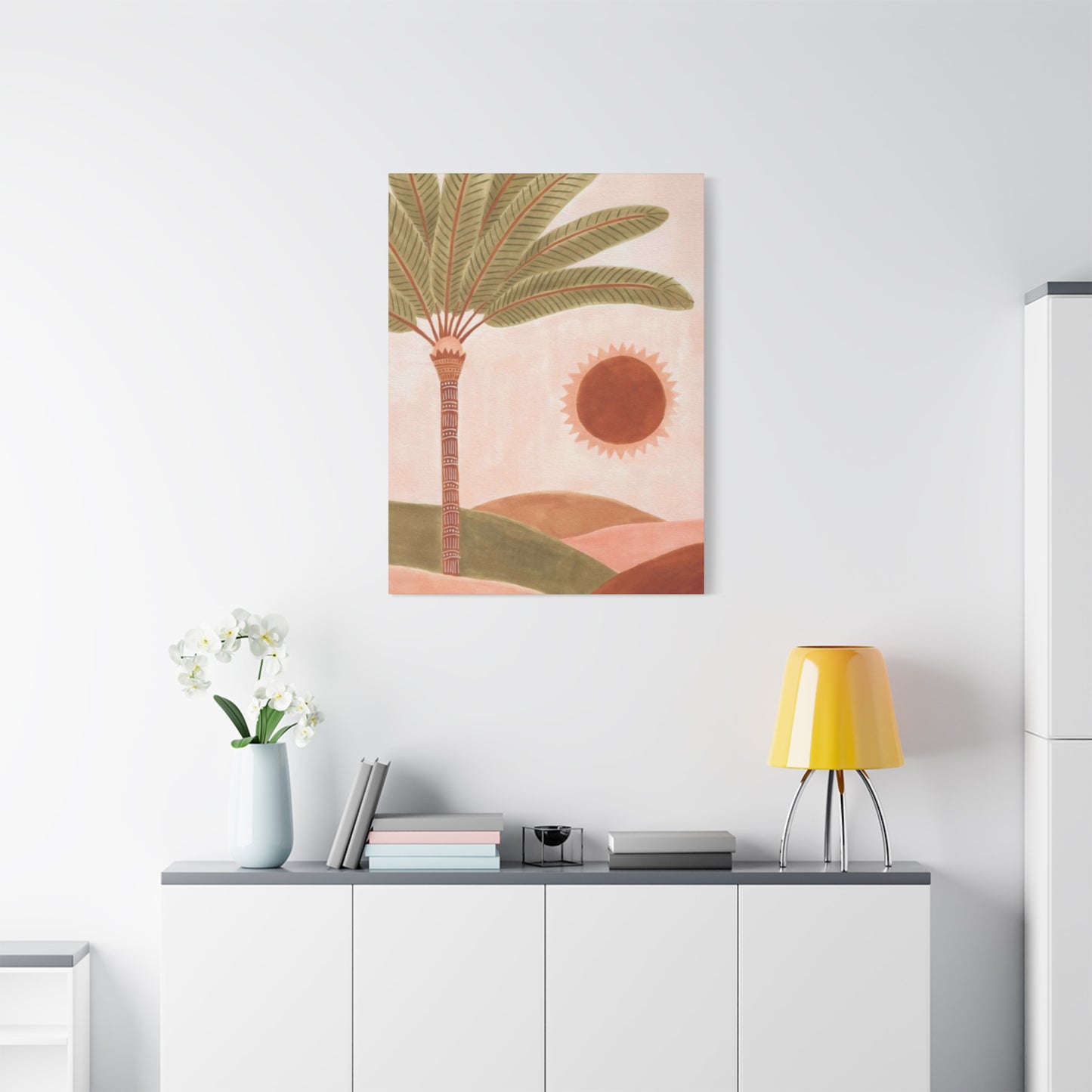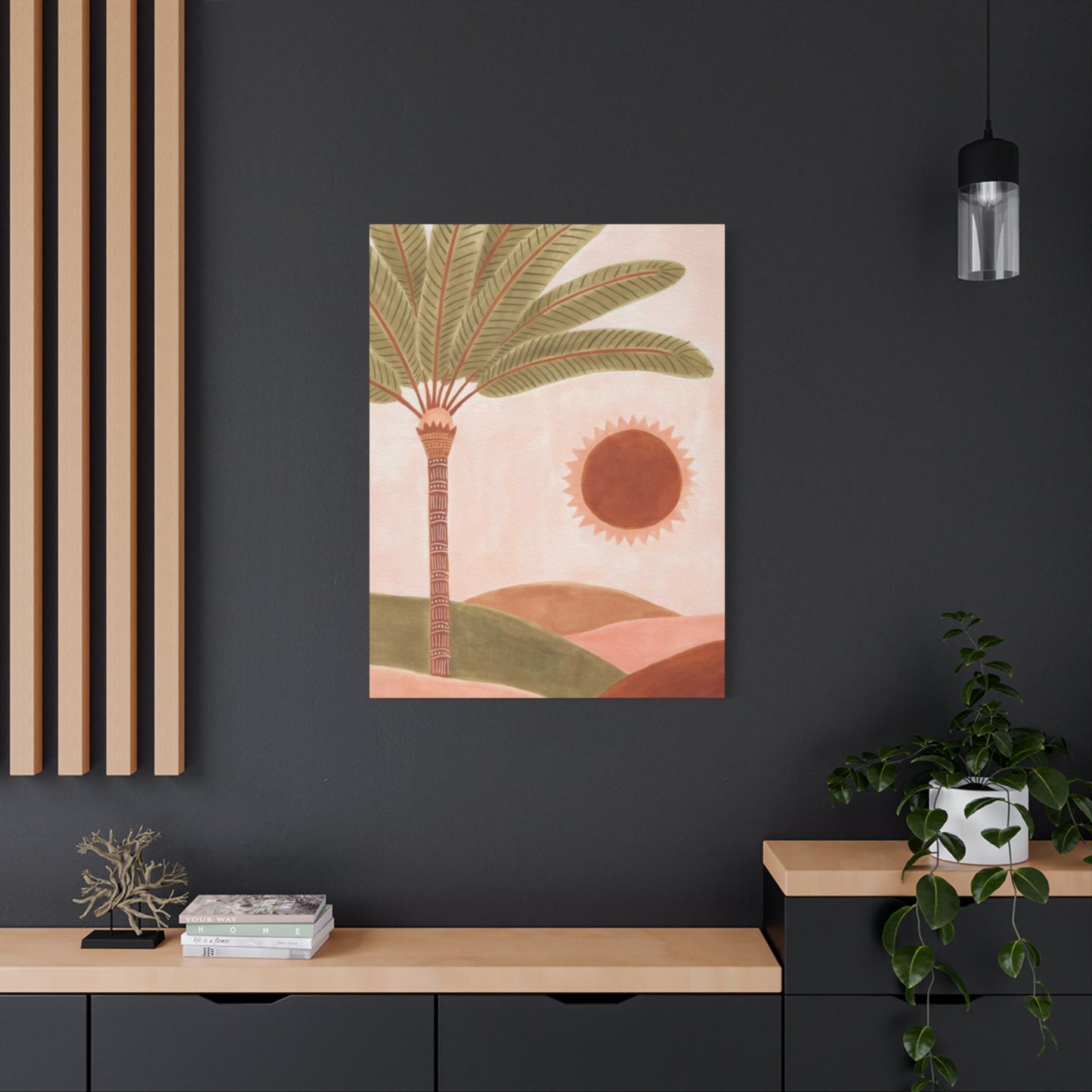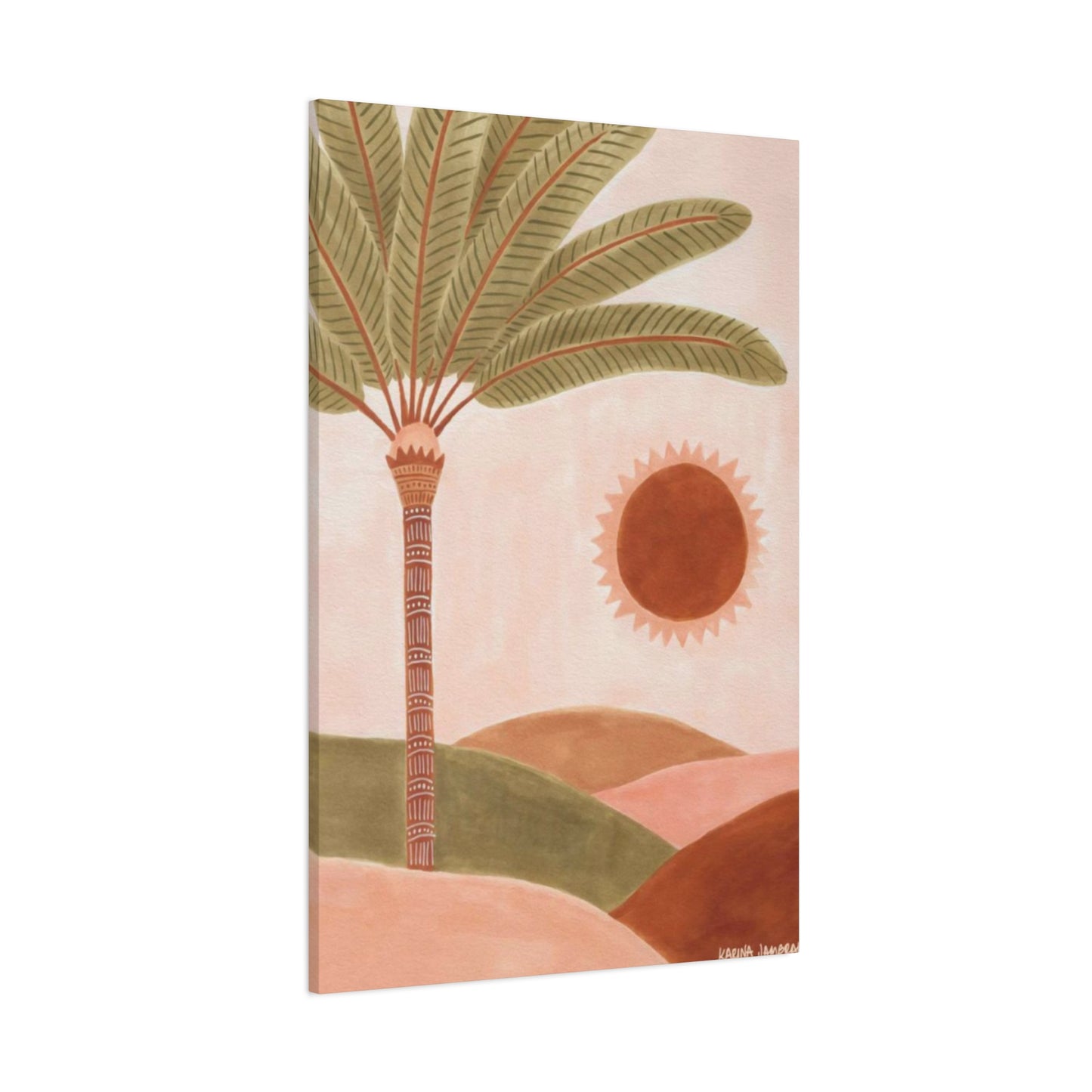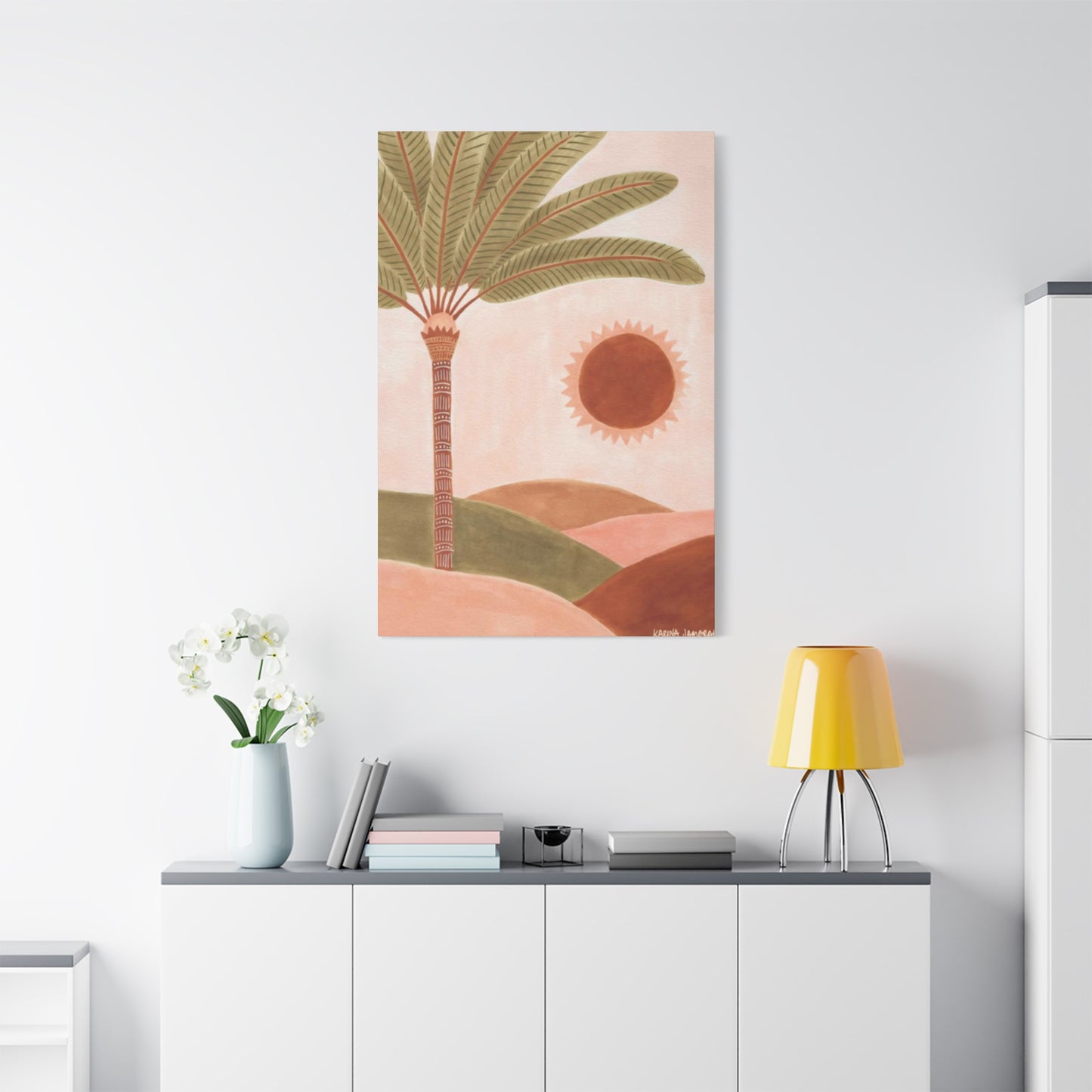Tropical Paradise: Palm Tree Painting Wall Art Canvas Prints for Modern Living
Desert palm tree paintings bring an extraordinary sense of tranquility and exotic beauty to any living environment. These magnificent canvas prints capture the essence of tropical landscapes, offering homeowners a unique opportunity to infuse their rooms with the serene atmosphere of distant paradises. The visual appeal of decorated desert palm tree artwork extends far beyond simple decoration, creating emotional connections that transform ordinary rooms into captivating sanctuaries.
The artistic representation of palm trees against desert backdrops provides a perfect balance between warmth and coolness, combining the golden hues of sandy landscapes with the refreshing green tones of tropical foliage. This harmonious color palette makes desert palm tree canvas prints incredibly versatile, allowing them to complement various color schemes while maintaining their distinctive character. Whether displayed in contemporary settings or traditional environments, these artistic pieces consistently deliver visual impact that captivates viewers and creates lasting impressions.
Modern homeowners increasingly seek artwork that tells stories and evokes emotions, making desert palm tree paintings particularly appealing for their ability to transport viewers to serene coastal locations. The detailed brushwork and carefully crafted compositions found in high-quality canvas prints ensure that each piece becomes a focal point that draws attention while maintaining artistic sophistication. These artworks successfully bridge the gap between natural beauty and artistic expression, offering viewers an escape from daily routines through their immersive visual narratives.
Selecting Perfect Canvas Print Dimensions for Your Living Environment
Choosing appropriate dimensions for palm tree canvas prints requires careful consideration of room proportions, viewing distances, and existing furniture arrangements. Large-scale artwork measuring 48 inches or more in width creates dramatic focal points that command attention and establish visual hierarchy within rooms. These substantial pieces work exceptionally well above sofas, beds, or dining tables where their impressive size can be fully appreciated without overwhelming surrounding elements.
Medium-sized canvas prints, typically ranging from 24 to 36 inches, offer versatility and adaptability for various placement options throughout homes. These dimensions provide sufficient visual presence to make meaningful contributions to room aesthetics while maintaining flexibility for future rearrangements. Medium-sized palm tree artwork works particularly well in bedrooms, home offices, and smaller living areas where intimate viewing experiences enhance the artwork's emotional impact.
Smaller canvas prints, measuring 16 to 24 inches, excel in creating gallery-style arrangements or serving as complementary pieces within larger artistic compositions. These compact dimensions allow for creative groupings that tell cohesive visual stories while maintaining individual artistic integrity. Multiple small palm tree prints can be arranged in grid patterns, asymmetrical compositions, or linear sequences that guide viewers' eyes through carefully planned visual journeys.
The relationship between artwork dimensions and room scale significantly influences the overall aesthetic impact of palm tree canvas prints. Oversized artwork in compact rooms can create feelings of confinement, while undersized pieces in expansive areas may appear insignificant or lost within the architectural context. Professional designers recommend measuring wall dimensions and considering viewing distances before making final selection decisions to ensure optimal visual balance and artistic effectiveness.
Color Psychology and Emotional Impact of Tropical Artwork
Palm tree canvas prints leverage powerful color psychology principles to influence mood, energy levels, and emotional responses within living environments. The dominant green tones found in tropical foliage promote feelings of tranquility, renewal, and connection with nature, making these artworks particularly effective for creating calming atmospheres in bedrooms and meditation areas. Green's association with growth, harmony, and balance contributes to the widespread appeal of palm tree imagery across diverse demographic groups.
Warm golden and amber hues commonly featured in desert palm tree paintings stimulate feelings of comfort, optimism, and warmth, making rooms feel more inviting and welcoming. These colors particularly benefit northern climates or rooms with limited natural light, where tropical artwork can compensate for environmental limitations through carefully selected color palettes. The psychological warmth generated by golden tones helps create cozy atmospheres that encourage relaxation and social interaction.
Blue elements often present in sky backgrounds or water features within palm tree compositions promote feelings of serenity, trust, and mental clarity. These cooler tones provide visual relief from warmer colors while contributing to the overall sense of escape and tranquility that makes tropical artwork so appealing. The combination of warm and cool tones creates visual interest and emotional depth that prevents artwork from becoming monotonous or visually stagnant.
Earth tones including browns, tans, and sandy beiges ground palm tree compositions and provide stability that balances more vibrant tropical colors. These neutral elements ensure that artwork remains sophisticated and timeless while still delivering the emotional benefits associated with tropical imagery. The careful integration of earth tones with more vibrant colors demonstrates the artistic skill required to create compelling palm tree canvas prints that maintain long-term appeal.
Strategic Placement Techniques for Maximum Visual Appeal
Strategic artwork placement significantly influences the effectiveness and visual impact of palm tree canvas prints within residential environments. Optimal positioning considers lighting conditions, traffic patterns, viewing angles, and relationship to existing architectural features. Professional placement techniques ensure that artwork receives appropriate attention while contributing positively to overall room composition and functionality.
Living room placement often centers around creating focal points that anchor seating arrangements and define conversation areas. Palm tree canvas prints positioned above sofas or behind seating areas establish visual weight that balances room proportions while providing pleasant viewing experiences for occupants and guests. The height placement typically follows the 57-inch rule, positioning artwork centers at eye level for seated viewers to ensure comfortable viewing angles.
Bedroom placement focuses on creating serene atmospheres that promote relaxation and peaceful sleep. Palm tree artwork positioned above headboards creates intimate viewing experiences that can be appreciated from bed while avoiding overwhelming visual stimulation that might interfere with rest. Alternative placement options include positioning artwork across from beds where it becomes the first visual element noticed upon waking, setting positive emotional tones for each day.
Hallway and corridor placement transforms transitional areas into gallery-like experiences that enhance the overall flow and connectivity between rooms. Palm tree canvas prints in these locations benefit from careful lighting consideration to ensure adequate illumination while avoiding glare that might diminish viewing quality. Strategic spacing between multiple pieces creates rhythm and visual progression that guides movement through architectural transitions.
Lighting Considerations for Canvas Print Enhancement
Proper lighting dramatically influences the visual impact and longevity of palm tree canvas prints, making illumination planning essential for optimal artistic presentation. Natural light provides the most accurate color reproduction and creates dynamic viewing experiences that change throughout daily cycles. However, direct sunlight exposure must be carefully managed to prevent fading and canvas deterioration over time.
Artificial lighting options include track lighting, picture lights, and accent spotlights that can be precisely positioned to eliminate shadows and enhance color vibrancy. LED lighting systems offer energy efficiency and minimal heat generation, making them ideal for canvas preservation while providing consistent illumination quality. The color temperature of artificial lighting should complement the warm tones typically found in palm tree artwork to maintain color harmony and visual appeal.
Avoiding harsh overhead lighting that creates unwanted shadows or reflections requires careful planning of fixture positions relative to artwork placement. Side lighting or angled illumination often provides more flattering results that enhance texture and dimensional qualities of canvas prints. Professional lighting designers recommend using multiple light sources at varying intensities to create layered illumination that adds depth and visual interest to artistic presentations.
Dimmer controls enable adjustment of lighting intensity for different occasions and times of day, allowing artwork to contribute appropriately to various mood settings. Evening illumination can create dramatic effects that transform palm tree paintings into captivating focal points, while daytime settings might emphasize natural color relationships and artistic details. This flexibility ensures that artwork remains engaging and relevant across different usage scenarios and personal preferences.
Maintenance and Preservation of Canvas Artwork
Proper maintenance ensures that palm tree canvas prints retain their visual appeal and structural integrity throughout years of display. Regular dusting using soft, dry brushes or microfiber cloths removes surface debris that can accumulate and diminish color vibrancy over time. Gentle cleaning techniques prevent damage to canvas surfaces while maintaining the pristine appearance that makes artwork visually compelling.
Environmental factors including humidity, temperature fluctuations, and air quality significantly impact canvas longevity and color stability. Maintaining consistent humidity levels between 45-55% prevents canvas expansion and contraction that can lead to cracking or warping. Temperature stability reduces stress on canvas materials and mounting systems, contributing to long-term structural integrity and visual consistency.
Protection from direct sunlight exposure prevents gradual fading that diminishes color intensity and artistic impact over time. UV-filtering glass or protective coatings can extend artwork lifespan while maintaining visual clarity and color accuracy. Strategic placement away from heat sources including fireplaces, heating vents, and high-intensity lighting fixtures prevents thermal damage that can cause canvas deterioration.
Professional cleaning services may be necessary for valuable pieces or artwork showing signs of significant dust accumulation or surface contamination. Expert conservation techniques ensure that cleaning processes enhance rather than damage artistic elements while preserving original color relationships and textural qualities. Regular professional assessment can identify potential issues before they become serious problems requiring expensive restoration work.
Creating Cohesive Room Themes with Tropical Elements
Palm tree canvas prints serve as excellent foundation pieces for developing cohesive tropical themes that extend throughout entire rooms or homes. The natural color palettes found in these artworks provide inspiration for selecting complementary furniture, textiles, and decorative accessories that reinforce tropical atmospheres. Successful thematic development requires careful balance between tropical elements and existing architectural features to avoid overwhelming or artificial results.
Furniture selection can echo tropical themes through natural materials including bamboo, rattan, and reclaimed wood that complement the organic qualities present in palm tree artwork. These materials provide textural variety while maintaining visual consistency with tropical imagery. Upholstery fabrics in natural fibers and earth tones support thematic unity while contributing to comfortable, inviting atmospheres that encourage relaxation and social interaction.
Decorative accessories including throw pillows, area rugs, and ceramic pieces can incorporate tropical motifs and color schemes that strengthen connections to palm tree artwork. However, restraint in accessory selection prevents themed environments from becoming overwhelming or cliché. The most successful tropical themes maintain sophistication through selective use of thematic elements rather than comprehensive tropical decoration throughout rooms.
Plant selections can reinforce tropical themes while adding living elements that complement static artwork. Large palm plants, tropical foliage, and flowering plants native to warm climates create layered visual experiences that enhance the naturalistic qualities of palm tree canvas prints. The combination of living and artistic tropical elements creates immersive environments that engage multiple senses while maintaining visual sophistication.
Budget-Friendly Approaches to Premium Artwork Acquisition
Acquiring high-quality palm tree canvas prints doesn't require substantial financial investment when approached strategically. Online marketplaces offer extensive selections at various price points, allowing buyers to compare options and find pieces that meet both aesthetic preferences and budget constraints. Digital printing technology has democratized access to museum-quality reproductions that deliver exceptional visual impact at affordable prices.
Timing purchases around seasonal sales, promotional events, and clearance periods can result in significant savings on premium canvas prints. Many online retailers offer regular discounts that make high-quality artwork accessible to broader audiences. Email newsletters and social media following can provide advance notice of upcoming sales and exclusive discount opportunities that maximize purchasing power.
DIY framing options reduce overall artwork costs while allowing for customization that perfectly matches room aesthetics and personal preferences. Pre-stretched canvases eliminate framing requirements entirely while maintaining professional appearance and durability. This approach enables investment in higher-quality prints while reducing ancillary costs associated with professional framing services.
Group purchasing with friends or family members can unlock volume discounts and shipping savings that reduce per-piece costs. This approach works particularly well for series purchases or when multiple people desire similar tropical artwork for their homes. Coordinated buying strategies can access wholesale pricing typically reserved for commercial customers or design professionals.
Seasonal Rotation Strategies for Dynamic Visual Interest
Rotating artwork seasonally maintains visual freshness and prevents tropical canvas prints from becoming stagnant or overlooked elements within rooms. This approach allows homeowners to enjoy variety while maximizing return on artwork investments through extended use cycles. Strategic rotation considers seasonal mood changes and lighting variations that influence how artwork appears and impacts room atmospheres.
Winter rotations might emphasize warmer tropical tones that compensate for reduced natural light and colder outdoor conditions. Palm tree paintings with golden sunsets or warm beach scenes provide psychological warmth during cold months when escape to tropical locations becomes particularly appealing. These images serve as daily reminders of warmer climates and future vacation possibilities.
Spring rotations can feature fresh, vibrant tropical scenes that echo natural renewal and growth occurring outdoors. Palm tree artwork with bright greens and clear blue skies complement seasonal energy increases and longer daylight hours. These selections support positive mood transitions as natural light increases and outdoor activities become more appealing.
Summer presentations might include dramatic sunset scenes or exotic tropical locations that complement vacation planning and outdoor living activities. Artwork selections can reflect increased social activity and entertainment that typically characterize summer months. These choices create conversation starters and enhance the welcoming atmospheres desired during peak entertaining seasons.
Fall rotations provide opportunities to emphasize earth tones and golden hues that harmonize with autumn foliage and harvest seasons. Palm tree artwork featuring amber sunsets or sandy beaches can maintain tropical escapism while acknowledging seasonal transitions and preparing for upcoming winter months.
Custom Framing Solutions for Enhanced Presentation
Custom framing elevates palm tree canvas prints from simple decorations to sophisticated artistic statements that command attention and respect within residential environments. Professional framing services offer numerous options for enhancing artwork presentation while protecting investment pieces from environmental damage and handling wear. The framing process provides opportunities for personalization that ensures artwork perfectly complements existing décor and architectural features.
Frame material selection significantly influences overall aesthetic impact and long-term durability of framed artwork. Wood frames in natural finishes complement the organic themes present in tropical artwork while providing structural strength and visual warmth. Metal frames offer contemporary appeal and precise manufacturing that ensures perfect alignment and professional appearance. Alternative materials including bamboo or composite options provide unique aesthetic qualities that may better suit specific decorative schemes.
Mat board selection creates visual separation between artwork and frames while providing opportunities for color customization that enhances overall presentation. Neutral mat colors including cream, ivory, and light gray provide timeless appeal that won't compete with artwork for attention. Colored mat boards can pick up accent colors from palm tree paintings to create cohesive visual relationships between artwork and framing elements.
Glass options including regular, anti-glare, and UV-filtering varieties provide different benefits for artwork preservation and viewing quality. Anti-glare glass reduces reflections that can interfere with artwork appreciation in brightly lit environments. UV-filtering glass provides superior protection against fading while maintaining excellent optical clarity for optimal viewing experiences.
Digital vs Physical Artwork Considerations
The decision between digital displays and physical canvas prints for palm tree artwork involves numerous factors including cost, flexibility, image quality, and long-term satisfaction. Digital displays offer unlimited content variety and instant changing capabilities that appeal to technology-oriented homeowners seeking maximum flexibility in their artistic choices. However, physical canvas prints provide tangible presence and authentic artistic experiences that digital displays cannot replicate.
Digital artwork displays excel in environments where frequent content changes are desired or where multiple family members have different artistic preferences. Smart displays and digital frames can cycle through extensive collections of palm tree imagery while occupying minimal wall area. These systems often include features like automatic brightness adjustment and color temperature modification that optimize viewing experiences throughout daily cycles.
Physical canvas prints deliver authentic artistic experiences with texture, dimensionality, and presence that engage viewers on multiple sensory levels. The tangible nature of canvas artwork creates emotional connections that digital displays struggle to replicate. Quality canvas prints maintain their visual appeal independently of electrical power or technical functionality, ensuring consistent artistic enjoyment regardless of technological issues or power outages.
Investment considerations favor physical canvas prints for their potential appreciation value and independence from technological obsolescence. High-quality original artwork or limited edition prints may increase in value over time, while digital displays depreciate rapidly as technology advances. Additionally, physical artwork can be relocated easily and doesn't require ongoing technical support or software updates to maintain functionality.
Environmental impact considerations may favor digital displays that eliminate printing, shipping, and framing materials associated with physical artwork. However, the energy consumption and electronic waste generated by digital displays over their operational lifespans may offset these initial environmental advantages. Careful analysis of long-term environmental impacts should inform decisions between digital and physical artwork options.
Psychological Benefits of Tropical Imagery in Living Areas
Tropical imagery, particularly palm tree representations, provides documented psychological benefits that contribute to improved mental health and overall well-being within residential environments. Research indicates that natural imagery reduces stress hormones and promotes relaxation responses that support better sleep quality and reduced anxiety levels. These benefits make palm tree canvas prints particularly valuable additions to bedrooms and meditation areas where psychological comfort is prioritized.
The escapist qualities inherent in tropical artwork provide mental relief from daily stresses and urban environments that may lack natural beauty. Palm tree paintings offer visual transportation to serene locations where viewers can mentally escape routine pressures and experience moments of tranquility. This psychological distancing effect contributes to improved emotional regulation and stress management capabilities that benefit overall quality of life.
Color therapy principles support the therapeutic value of tropical color palettes commonly found in palm tree artwork. Green tones promote healing and renewal while reducing eye strain and mental fatigue. Blue elements encourage calm reflection and mental clarity that support decision-making and problem-solving activities. The combination of these therapeutic colors creates environments that actively support psychological well-being and emotional stability.
Biophilic design principles recognize humans' innate connection to natural environments and the psychological benefits derived from nature-inspired decorative elements. Palm tree artwork satisfies biophilic needs in urban environments where direct nature contact may be limited. This connection to natural imagery supports cognitive function improvement and creativity enhancement that benefit both personal and professional activities conducted within homes.
Social psychology research suggests that nature-inspired artwork promotes positive social interactions and conversation development. Palm tree paintings serve as conversation starters that encourage sharing of travel experiences, future vacation planning, and positive memory recollection. These social benefits contribute to stronger relationships and more engaging home entertaining experiences.
Technology Integration for Modern Display Solutions
Modern technology offers innovative approaches to displaying and enhancing palm tree canvas prints that extend beyond traditional hanging methods. Smart lighting systems can be programmed to highlight artwork at optimal times and intensities while responding to natural light changes throughout daily cycles. These automated systems ensure consistent artwork presentation while reducing energy consumption through intelligent lighting management.
Augmented reality applications enable virtual preview of palm tree artwork within actual room environments before purchase decisions are made. This technology reduces uncertainty about size, color compatibility, and placement effectiveness while enabling more confident buying decisions. Virtual placement capabilities help optimize room layouts and identify the most effective positioning for maximum visual impact.
Digital catalog systems and inventory management applications help collectors track artwork locations, rotation schedules, and maintenance requirements. These organizational tools become particularly valuable as collections grow and rotation strategies become more complex. Digital tracking ensures that valuable pieces receive appropriate care while maximizing enjoyment through strategic display scheduling.
Home automation integration allows artwork lighting and environmental controls to be coordinated with daily schedules and seasonal changes. Automated systems can adjust lighting intensity, color temperature, and timing to enhance artwork presentation while supporting circadian rhythm regulation. These sophisticated control systems provide convenience while optimizing both artwork preservation and viewer experience.
Social media integration enables sharing of artwork displays and rotation strategies with online communities of art enthusiasts and home decorators. Digital platforms provide inspiration sources and expert advice that support continued learning and improvement in artwork selection and display techniques. Online communities offer support networks for collectors and decorators seeking to maximize their artistic investments.
Professional Installation Services and DIY Alternatives
Professional installation services ensure optimal placement and secure mounting for valuable palm tree canvas prints while providing expertise that maximizes visual impact and long-term stability. Experienced installers assess wall conditions, identify optimal hanging heights, and recommend hanging hardware appropriate for artwork dimensions and weight. Professional services particularly benefit large-scale pieces or complex gallery arrangements that require precise alignment and spacing.
DIY installation approaches offer cost savings and scheduling flexibility while enabling hands-on involvement in artwork presentation decisions. Modern hanging hardware systems simplify installation processes while providing secure mounting that rivals professional results. However, DIY approaches require careful attention to wall type, stud location, and weight distribution to ensure safe and stable artwork display.
Wall assessment procedures identify structural limitations and appropriate mounting methods for different wall types including drywall, plaster, brick, and concrete. Hollow walls require anchor systems that distribute weight across multiple attachment points, while solid walls may accommodate simpler mounting approaches. Understanding wall construction prevents damage and ensures stable long-term artwork display.
Tool requirements for professional-quality installation include laser levels, stud finders, drill bits appropriate for specific wall materials, and measuring devices that ensure accurate placement. Quality hanging hardware including picture wire, D-rings, and security hanging systems provide multiple options for different artwork types and security requirements. Investment in proper tools supports multiple installation projects while ensuring professional results.
Safety considerations during installation prevent injury and property damage while ensuring secure artwork mounting. Ladder safety, electrical awareness around light fixtures and switches, and proper lifting techniques protect installers and surrounding property. Following manufacturer guidelines for hanging hardware ensures that weight ratings and installation procedures are respected for optimal safety and stability.
Art Curation Principles for Personal Collections
Developing cohesive palm tree artwork collections requires understanding fundamental curation principles that ensure individual pieces complement each other while contributing to unified aesthetic experiences. Successful curation balances variety with consistency, creating collections that maintain visual interest without appearing random or disconnected. Professional curation approaches consider color relationships, stylistic consistency, and thematic development throughout collection growth.
Color palette coordination ensures that multiple palm tree pieces work harmoniously within shared environments while allowing for individual artistic expression. Collections might focus on specific color families such as warm tropical tones or cool coastal palettes to maintain visual consistency. Alternatively, graduated color progressions can create dynamic visual experiences that guide viewers through carefully planned aesthetic journeys.
Artistic style consideration prevents collections from appearing haphazard or lacking professional curation. Collections might focus on specific artistic approaches such as photorealistic representations, impressionistic interpretations, or abstract tropical themes. Maintaining stylistic consistency while allowing for individual artistic expression creates sophisticated collections that demonstrate curatorial expertise and aesthetic understanding.
Scale variation within collections creates visual rhythm and prevents monotonous gallery presentations. Combining large statement pieces with medium and small works provides flexibility for different display configurations while ensuring that collections can adapt to various room layouts and architectural features. Strategic scale relationships create hierarchy and focal points that guide viewer attention through planned visual progressions.
Quality standards ensure that collection additions meet consistent criteria for artistic merit, production quality, and long-term value. Establishing minimum quality thresholds prevents impulsive purchases that may diminish overall collection impact. Consistent quality standards support collection value appreciation while ensuring that individual pieces contribute positively to unified aesthetic experiences.
Market Analysis and Investment Potential
The market for tropical artwork, particularly palm tree themed pieces, demonstrates consistent demand driven by tourism industries, hospitality sectors, and residential decorating trends. Understanding market dynamics helps collectors make informed decisions about acquisition timing, artist selection, and long-term investment potential. Market analysis considers factors including artist reputation, print availability, and cultural trends that influence artwork values.
Limited edition prints typically offer greater investment potential than unlimited reproductions due to scarcity factors that drive collector interest and value appreciation. Numbered editions with certificate authentication provide verification that supports resale value and collector confidence. However, limited availability may limit initial accessibility and require higher initial investment levels that may not suit all budget requirements.
Artist reputation significantly influences artwork investment potential and long-term value stability. Established artists with gallery representation and exhibition history provide greater investment security than unknown creators. However, emerging artists may offer superior value appreciation potential for collectors willing to accept higher risk levels. Balanced collection strategies might include both established and emerging artist works to optimize risk and return potential.
Market timing considerations include seasonal demand patterns, economic conditions, and cultural trend cycles that influence artwork values and availability. Tourist season peaks often drive demand for tropical artwork as travelers seek to capture vacation memories through artistic purchases. Economic uncertainty may create buying opportunities as sellers reduce prices to stimulate demand during challenging market conditions.
Authentication and provenance documentation support artwork investment value by providing verification of artist attribution and legal ownership history. Proper documentation becomes increasingly important as collections grow and estate planning considerations develop. Maintaining detailed records supports insurance claims and resale transactions while protecting against fraud and ownership disputes.
Regional and Cultural Influences on Tropical Art Appreciation
Geographic location significantly influences appreciation and market demand for palm tree artwork, with coastal regions and warmer climates showing higher demand levels than inland or colder areas. However, psychological escape desires often drive strong demand in regions with harsh winters or limited natural beauty where tropical artwork provides yearround connection to warmer, more appealing environments.
Cultural background influences artistic preferences and interpretation of tropical imagery, with some cultures viewing palm trees as symbols of prosperity and paradise while others associate them with leisure and vacation experiences. Understanding cultural context helps predict market demand and guides collection development strategies that align with target audience preferences and expectations.
Tourism industry connections create consistent demand for tropical artwork in hospitality sectors including hotels, restaurants, and resort properties that seek to reinforce destination themes and create immersive guest experiences. Commercial demand often drives artistic production and influences available styles and price points in consumer markets, creating opportunities for residential collectors to benefit from hospitality industry volume production.
International market influences include import/export considerations, currency exchange rates, and shipping logistics that affect artwork availability and pricing in different regions. Global art markets provide access to diverse artistic styles and price points while creating opportunities for arbitrage between regional markets with different supply and demand characteristics.
Economic development patterns in tropical regions often influence authentic cultural art production and availability, with tourism development supporting local artist communities while potentially commercializing traditional artistic approaches. Collectors interested in authentic cultural representation may need to navigate between commercial and traditional artistic sources to find pieces that meet their authenticity standards.
Environmental Impact and Sustainable Art Practices
Sustainable art production practices minimize environmental impact while maintaining quality and aesthetic appeal that meets collector expectations. Canvas production methods, printing processes, and shipping logistics all contribute to environmental footprints that environmentally conscious collectors may consider in their purchasing decisions. Understanding sustainability factors enables informed choices that align personal values with artistic investments.
Canvas material sourcing includes options ranging from traditional cotton to recycled fibers and sustainable bamboo alternatives that reduce agricultural impact and resource consumption. Eco-friendly canvas options often provide comparable quality and longevity to traditional materials while supporting environmental responsibility. However, availability and pricing may limit accessibility for budget-conscious collectors.
Printing technology advances include water-based inks, reduced chemical processing, and energy-efficient production methods that minimize environmental impact without compromising image quality. Digital printing processes generally produce less waste than traditional printing methods while enabling on-demand production that eliminates inventory waste and overproduction issues.
Packaging and shipping considerations include recyclable materials, minimal packaging approaches, and carbon-neutral shipping options that reduce transportation impact. Local sourcing strategies minimize shipping distances while supporting regional artistic communities and reducing carbon footprints associated with long-distance transportation. These approaches may limit selection variety but support sustainability goals.
Longevity and durability considerations support sustainability by ensuring that artwork purchases provide extended service life that justifies resource consumption during production. High-quality materials and construction methods prevent premature replacement needs while maintaining visual appeal throughout extended display periods. Investment in quality supports both economic and environmental sustainability through reduced replacement frequency.
Insurance and Protection Strategies for Art Collections
Protecting valuable palm tree artwork collections requires comprehensive insurance strategies that address theft, damage, and natural disaster risks while providing adequate coverage levels that reflect current market values. Homeowner insurance policies often provide limited coverage for artwork that may not reflect actual replacement costs or include specific risks associated with art collection ownership.
Specialized art insurance policies provide coverage specifically designed for collectors and include benefits such as appreciation coverage, restoration cost coverage, and temporary placement services during claim processing. These policies often include expert appraisal services and conservation advice that support collection preservation while providing superior claim handling for art-specific issues.
Security considerations include alarm systems, surveillance cameras, and environmental monitoring that protect against theft while documenting storage conditions that may affect artwork preservation. Security system integration with insurance policies may provide premium discounts while demonstrating commitment to risk reduction that benefits both collectors and insurance providers.
Documentation requirements include detailed inventory records, professional appraisals, and condition reports that support insurance claims while providing historical records of collection development. Digital documentation including high-resolution photographs provides verification of condition and authenticity that supports claim processing and aids in recovery efforts following theft or damage incidents.
Risk assessment procedures identify potential threats including environmental hazards, security vulnerabilities, and handling risks that may affect collection safety. Regular risk evaluation enables proactive prevention measures while ensuring that insurance coverage remains adequate as collections grow and values appreciate over time.
Future Trends in Tropical Wall Art and Display Technology
Emerging technologies promise revolutionary changes in how tropical artwork is created, displayed, and experienced within residential environments. Artificial intelligence applications in art creation enable personalized artwork generation that responds to individual preferences while maintaining professional quality standards. These technologies may democratize custom art creation while reducing costs associated with commissioned works.
Virtual and augmented reality applications provide immersive experiences that extend beyond traditional static artwork display. Future developments may enable viewers to virtually visit depicted tropical locations or interact with artwork elements in ways that enhance engagement and emotional connection. These technologies create opportunities for enhanced therapeutic benefits and entertainment value that traditional artwork cannot provide.
Smart home integration continues advancing with systems that automatically adjust lighting, temperature, and humidity to optimize artwork preservation while enhancing viewing experiences. Future developments may include artwork rotation systems, environmental adaptation technologies, and health monitoring systems that track artwork condition and alert collectors to potential preservation issues.
Sustainable production technologies focus on reducing environmental impact while maintaining or improving quality standards. Innovations in materials science may provide new canvas options, eco-friendly ink formulations, and energy-efficient production methods that appeal to environmentally conscious collectors. These developments support market growth while addressing environmental concerns that influence purchasing decisions.
Market evolution includes increasing democratization of art collection through digital platforms, fractional ownership models, and subscription services that provide access to diverse artwork selections without traditional ownership requirements. These models may increase market participation while providing flexibility that appeals to younger demographics and changing lifestyle preferences.
Health and Wellness Benefits of Nature-Inspired Artwork
Scientific research demonstrates measurable health benefits associated with nature-inspired artwork display, including reduced blood pressure, decreased stress hormone levels, and improved cognitive function. Palm tree imagery specifically provides psychological benefits associated with vacation memories and escape fantasies that contribute to mental health improvement. These documented benefits support therapeutic applications in healthcare environments and wellness-focused residential design.
Sleep quality improvement results from calming tropical imagery that promotes relaxation and positive mental associations before bedtime. Bedroom display of palm tree artwork may contribute to improved sleep onset and quality through psychological relaxation responses and positive dream content influence. These benefits particularly appeal to individuals experiencing stress-related sleep difficulties or anxiety disorders.
Productivity enhancement in home office environments results from nature imagery that reduces mental fatigue and supports sustained concentration. Palm tree artwork provides visual relief from computer screens while maintaining professional appearance that supports business activities. The combination of aesthetic appeal and psychological benefits makes tropical artwork particularly suitable for work-from-home environments.
Social interaction benefits include conversation stimulation and positive mood enhancement that supports entertaining and family activities. Palm tree artwork serves as icebreakers for guests while creating positive emotional atmospheres that encourage social engagement. These benefits contribute to improved relationship quality and enhanced home entertainment experiences.
Pain management applications in healthcare settings demonstrate reduced perceived pain levels and decreased medication requirements when patients have access to nature-inspired artwork. While residential applications may not replicate clinical settings, similar psychological mechanisms may provide comfort benefits for individuals managing chronic conditions or recovering from medical procedures.
Professional Development for Art Collectors and Enthusiasts
Developing expertise in tropical art appreciation requires ongoing education through gallery visits, artist studies, and market research that builds understanding of artistic merit and investment potential. Professional development opportunities include workshops, seminars, and certification programs that provide structured learning experiences for serious collectors seeking to improve their knowledge and decision-making capabilities.
Networking opportunities through collector groups, gallery events, and online communities provide access to expert knowledge and market insights that benefit collection development strategies. Professional relationships with gallery owners, artists, and fellow collectors create support networks that provide advice, buying opportunities, and market intelligence that improves collection outcomes.
Conservation knowledge development includes learning proper handling, storage, and maintenance techniques that preserve artwork while preventing damage that could diminish value or visual appeal. Understanding conservation principles enables informed decisions about restoration needs while supporting long-term collection preservation goals.
Market analysis skills development includes learning to evaluate artist potential, assess market trends, and identify undervalued opportunities that support collection growth and investment objectives. Professional market analysis requires understanding of auction results, gallery pricing, and economic factors that influence art market performance.
Technology utilization in collection management includes database systems, valuation tracking, and digital documentation that support professional collection management practices. Modern collectors benefit from understanding available technologies while implementing systems that support their specific collection goals and management requirements.
Conclusion
The world of tropical palm tree canvas prints offers endless possibilities for enhancing living environments while providing psychological benefits that contribute to overall well-being and life satisfaction. From understanding color psychology and emotional impact to mastering placement techniques and maintenance strategies, successful artwork integration requires knowledge, planning, and attention to detail that transforms ordinary rooms into extraordinary personal sanctuaries.
The investment potential of quality palm tree artwork extends beyond immediate aesthetic benefits to include long-term value appreciation and market opportunities that reward informed collecting strategies. Understanding market dynamics, artist reputation factors, and authentication requirements enables collectors to make confident decisions that support both personal enjoyment and financial objectives. The growing demand for tropical imagery, driven by tourism influences and psychological wellness awareness, creates favorable market conditions for both new and experienced collectors.
Modern technology integration offers unprecedented opportunities for artwork display, management, and appreciation that enhance traditional collecting experiences while providing new avenues for engagement and enjoyment. Smart home systems, digital cataloging, and virtual reality applications create exciting possibilities for future artwork interaction that extend far beyond conventional display methods. These technological advances democratize access to professional-quality collection management while providing tools that support sophisticated curatorial approaches.
Environmental sustainability considerations increasingly influence art market dynamics and collector preferences, creating opportunities for conscious collecting that aligns personal values with aesthetic investments. Sustainable production methods, eco-friendly materials, and carbon-neutral shipping options enable collectors to enjoy beautiful artwork while supporting environmental responsibility. These considerations become particularly relevant for tropical artwork that celebrates natural beauty and environmental appreciation.
The therapeutic benefits of nature-inspired artwork provide compelling justification for investment in quality palm tree canvas prints that serve dual purposes as artistic statements and wellness tools. The documented psychological benefits including stress reduction, sleep improvement, and social interaction enhancement make tropical artwork particularly valuable additions to modern homes where mental health and well-being receive increasing attention and priority.
Professional development opportunities in art appreciation, market analysis, and collection management enable enthusiasts to maximize their investment returns while deepening their appreciation for artistic merit and cultural significance. The combination of aesthetic enjoyment, investment potential, and personal development makes palm tree artwork collection a rewarding pursuit that provides lifelong learning opportunities and continued satisfaction.
Future trends in artwork creation, display technology, and market evolution promise exciting developments that will expand possibilities for tropical art appreciation while maintaining the fundamental appeal of beautiful imagery that connects viewers with natural beauty and exotic destinations. The enduring popularity of palm tree themes across cultures and generations suggests continued market strength and appreciation potential that benefits current and future collectors.

















